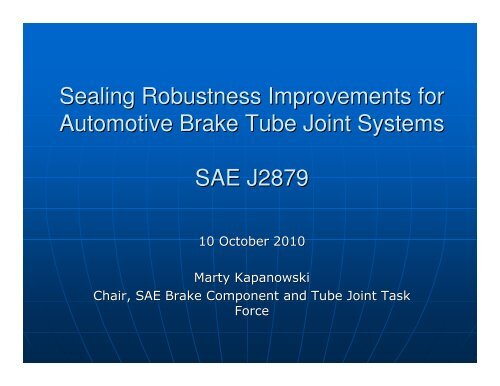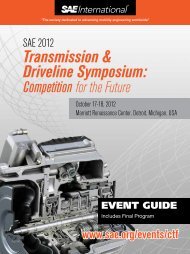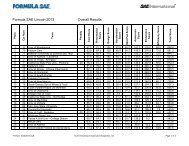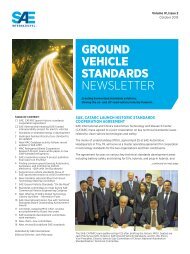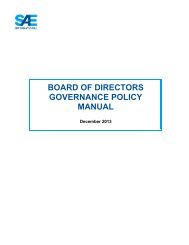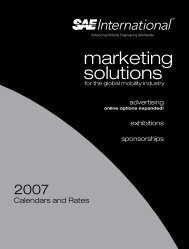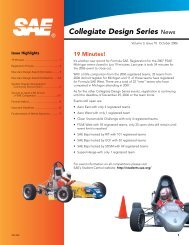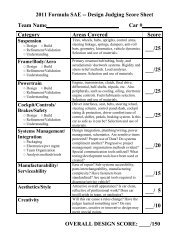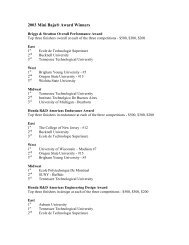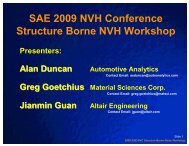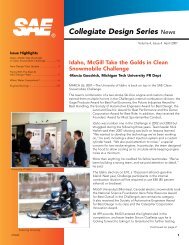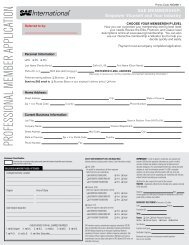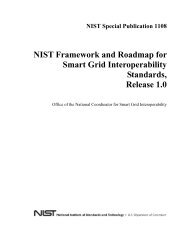Sealing Robustness Improvements for Automotive Brake Tube ... - SAE
Sealing Robustness Improvements for Automotive Brake Tube ... - SAE
Sealing Robustness Improvements for Automotive Brake Tube ... - SAE
Create successful ePaper yourself
Turn your PDF publications into a flip-book with our unique Google optimized e-Paper software.
<strong>Sealing</strong> <strong>Robustness</strong> <strong>Improvements</strong> <strong>for</strong><br />
<strong>Automotive</strong> <strong>Brake</strong> <strong>Tube</strong> Joint Systems<br />
<strong>SAE</strong> J2879<br />
10 October 2010<br />
Marty Kapanowski<br />
Chair, <strong>SAE</strong> <strong>Brake</strong> Component and <strong>Tube</strong> Joint Task<br />
Force
Overview<br />
�� <strong>Automotive</strong> Hydraulic <strong>Brake</strong> Systems Contain ~15-20 ~15 20 High<br />
Pressure <strong>Brake</strong> <strong>Tube</strong> Joints<br />
�� Building 1000 Units/Day Gives ~20,000 Opportunities For<br />
Leaks/Day<br />
�� Assembly Plants Have Difficulty Managing >~20 “<strong>Brake</strong> <strong>Brake</strong><br />
Jobs” Jobs Per Day Equating to Leaks On 0.1% of the Joints<br />
Secured That Day<br />
�� Leak Outbreaks Consume Hundreds of Thousands of Dollars<br />
Per Year in Engineers’ Engineers Time, Part Cost, Lab Analysis and<br />
Shipping, Often With No Tangible Result<br />
Question: Can <strong>SAE</strong> standards be updated to improve sealing<br />
per<strong>for</strong>mance of automotive brake tube joints?<br />
10 October 2010 Kapanowski - <strong>SAE</strong> J2879 2
First, Assemble a Team
First, Assemble a Team
<strong>Brake</strong> Component and <strong>Tube</strong> Joint Task Force<br />
Louis Damanti<br />
Bosch<br />
Jerome Schultz<br />
Bosch<br />
Paul Kuehl<br />
Chrysler<br />
Dr Ing Han Zhao<br />
Continental<br />
Leah Duby<br />
Continental<br />
Mike VanHorn<br />
Cooper Standard<br />
Janet Callahan<br />
Ford<br />
Marty Kapanowski<br />
Ford<br />
Karl Kleinhardt<br />
GM<br />
Randy Green<br />
Harco<br />
Dave Homan<br />
Harco<br />
Paul Carey<br />
Hi-Vol Hi Vol<br />
Steve Kacines<br />
Hitachi<br />
Myles Davis<br />
Independent<br />
Sean Peterson<br />
Martinrea<br />
Paul Gritt<br />
Paul Gritt Consulting<br />
Micheline Brussow<br />
<strong>SAE</strong><br />
Jana Wright<br />
<strong>SAE</strong><br />
Larry Bishop<br />
TI <strong>Automotive</strong><br />
Bruce Amble<br />
Toyota<br />
Jessica Marie Federico<br />
Toyota<br />
Chris Roberts<br />
TRW<br />
10 October 2010 Kapanowski - <strong>SAE</strong> J2879 5
Next, Fully Understand Current<br />
Standards, Generate Agreement on How<br />
the Joint Should Seal, and Why It<br />
Sometimes Does Not
Two Joint In Common Use Today<br />
Double Inverted Flare “ISO ISO” or “Bubble Bubble” Flare<br />
Task Force Consensus: Target<br />
90-Degree 90 Degree Inverted Flare<br />
10 October 2010 Kapanowski - <strong>SAE</strong> J2879 7
How Does An Inverted Flare Joint Seal?<br />
�� Sounds Simple:<br />
• Take Four Soft Metal Cones ~4mm Diameter<br />
• Stack Them Up<br />
• Squash Them Together By Applying 1800 lbs<br />
Force To the Top Cone<br />
• Expect Continuous 360-degree 360 degree Contact<br />
Between the Bottom Two Cones,<br />
With Gap < ~10 microns<br />
10 October 2010 Kapanowski - <strong>SAE</strong> J2879 8
F<br />
Four Conic Sections (Frustums)<br />
Nose of Nut<br />
Back of Flare<br />
Flare <strong>Sealing</strong> Surface<br />
Port Cone Seat<br />
10 October 2010 Kapanowski - <strong>SAE</strong> J2879 9
Four Conic Sections (Frustums)<br />
This Should Seal Nicely<br />
F<br />
Nose of Nut<br />
Back of Flare<br />
Flare <strong>Sealing</strong> Surface<br />
Port Cone Seat<br />
10 October 2010 Kapanowski - <strong>SAE</strong> J2879 10
Four Frustums<br />
Nose of Nut<br />
Back of Flare<br />
Flare <strong>Sealing</strong> Surface<br />
Port Cone Seat<br />
…Not Not So Much<br />
10 October 2010 Kapanowski - <strong>SAE</strong> J2879 11<br />
F
Two Main Factors For <strong>Sealing</strong><br />
1. Geometry – Tolerances Are Not Zero<br />
2. Clampload – Required To De<strong>for</strong>m Metal To<br />
Close Gaps Due To Non-Zero Non Zero Tolerances<br />
J2879 Addresses Geometry Effects, to Improve<br />
<strong>Sealing</strong> <strong>Robustness</strong> at a Given Clampload<br />
10 October 2010 Kapanowski - <strong>SAE</strong> J2879 12
Having Settled on Scope of Addressing<br />
Geometry, Now Determine Which Elements of<br />
Geometry to Analyze and Update
Geometry Observations<br />
�� Alignment<br />
• Flare to seat<br />
• Nut to flare<br />
• Lateral stackup<br />
10 October 2010 Kapanowski - <strong>SAE</strong> J2879 14
Interactions Between the Four Frustums<br />
<strong>Tube</strong> Does Not Drive<br />
Self-Centering<br />
Self Centering<br />
Contact<br />
Cone<br />
De<strong>for</strong>mation<br />
In Spec!<br />
10 October 2010 Kapanowski - <strong>SAE</strong> J2879 15
Flare / Seat Interactions<br />
Cone de<strong>for</strong>ms, not flare, contrary to popular belief<br />
10 October 2010 Kapanowski - <strong>SAE</strong> J2879 16
Nut / Flare Interactions<br />
3/16” 3/16 Sealer ¼” Leaker<br />
Was This Difference Due To Variation Alone?<br />
10 October 2010 Kapanowski - <strong>SAE</strong> J2879 17
3<br />
/<br />
1<br />
6<br />
1<br />
/<br />
4<br />
5<br />
/<br />
1<br />
6<br />
Nut / Flare Interactions<br />
For larger spec tube sizes, tube nut contacts further up the flare flare<br />
<strong>SAE</strong> J533 & JASO F402 - Nut Outer Contact Point Range vs. <strong>Tube</strong> Flare Radius<br />
<strong>SAE</strong> JASO<br />
3.4 - 3.53<br />
3.37 - 3.555<br />
kapanow ski/callahan 11/2/07<br />
<strong>SAE</strong> JASO<br />
4.2 - 4.33<br />
3.4 - 3.45<br />
3.3 - 3.6<br />
4.386 - 4.57<br />
<strong>SAE</strong> JASO<br />
4.99 - 5.12<br />
4.275 - 4.575<br />
5.21 - 5.935<br />
5.25 - 5.55<br />
10 October 2010 Kapanowski - <strong>SAE</strong> J2879 18<br />
4.2 - 4.25<br />
<strong>Tube</strong> Flare<br />
Rad.<br />
Nut<br />
Outer<br />
Contact<br />
Nut Outer Contact Point Range<br />
5.2 - 5.25<br />
<strong>Tube</strong> Flare Radius Range<br />
Nut<br />
<strong>Tube</strong><br />
Nut<br />
<strong>Tube</strong>
Nut / Flare / Port Interactions<br />
JASO F402 / <strong>SAE</strong> J533 – Not to scale – Proportions exaggerated to show differences<br />
3/16” / 4.75mm ¼” / 6.0mm<br />
5/16” / 8.0mm<br />
End view of this corner of tube flare can look like this. It is free-<strong>for</strong>m mat’l. Checked by<br />
pin gage <strong>for</strong> min diameter only.<br />
Poor initial contact surface.<br />
10 October 2010 Kapanowski - <strong>SAE</strong> J2879 19
Nut / Flare / Port Interactions<br />
Q: Why Do Current Specifications Change Nut/Flare/Port<br />
Contact Relationship As <strong>Tube</strong> Diameter Increases?<br />
10 October 2010 Kapanowski - <strong>SAE</strong> J2879 20
Nut / Flare / Port Interactions<br />
Q: Why Do Current Specifications Change Nut/Flare/Port<br />
Contact Relationship As <strong>Tube</strong> Diameter Increases?<br />
A: After Considerable Investigation, There Seems To Be<br />
No Good Reason!<br />
10 October 2010 Kapanowski - <strong>SAE</strong> J2879 21
Interim Conclusions<br />
�� The sealing robustness of the inverted flare brake tube joint<br />
is higher in 3/16" applications than in 1/4" and 5/16"<br />
applications.<br />
�� Geometry differences between robust and non-robust non robust joints<br />
can be observed and quantified<br />
�� The candidate areas <strong>for</strong> improvement are primarily in the<br />
flare thickness variation (TV) control, concentricity control,<br />
and consistency of nut/flare/port interaction across all tube<br />
sizes.<br />
�� If we are going to address interactions, let’s let s put all the joint<br />
components into a single standard <strong>for</strong> ease of use and<br />
consistency<br />
10 October 2010 Kapanowski - <strong>SAE</strong> J2879 22
<strong>SAE</strong> <strong>Brake</strong> Component and <strong>Tube</strong> Joint Task Force<br />
Consensed Scope (Sept 2008)<br />
�� Create a standard which defines the tube flare (90-degree<br />
(90 degree<br />
double inverted flare), tube nut and port <strong>for</strong> 5, 6, and 8mm<br />
(3/16", 1/4" and 5/16") high pressure hydraulic<br />
connections, in a single document. Dimensional definitions<br />
will take into account industry experience with the joint in<br />
terms of improving manufacturability, first-time first time sealing<br />
robustness, and commonality of usage across OEMs and<br />
component manufacturers.<br />
10 October 2010 Kapanowski - <strong>SAE</strong> J2879 23
Meeting Schedule<br />
�� Initially bi-weekly bi weekly face-to face to-face face at <strong>SAE</strong> ~ 6 months<br />
�� Changed to weekly given quantity of work to be done<br />
�� After relationship-building relationship building and initial sketches/discussions/<br />
current spec consolidations complete, moved to<br />
Webex/Conference Webex/Conference<br />
Call<br />
�� Periodic face-to face to-face face meetings as needed<br />
10 October 2010 Kapanowski - <strong>SAE</strong> J2879 24
Process<br />
�� Recognize and reconcile all theories of operation<br />
�� Assemble all existing specs into one matrix, pick optimum<br />
dimensions <strong>for</strong> each characteristic<br />
�� Per<strong>for</strong>m stack-ups stack ups and mfg feasibility analyses<br />
�� Generate global agreement (OEM and Supplier)<br />
�� Build and test parts<br />
�� Review and concur on results<br />
�� Send spec <strong>for</strong> ballot (1 Oct 2010)<br />
10 October 2010 Kapanowski - <strong>SAE</strong> J2879 25
10 October 2010 Kapanowski - <strong>SAE</strong> J2879 26
10 October 2010 Kapanowski - <strong>SAE</strong> J2879 27
10 October 2010 Kapanowski - <strong>SAE</strong> J2879 28
Result<br />
10 October 2010 Kapanowski - <strong>SAE</strong> J2879 29
<strong>SAE</strong> J2879<br />
10 October 2010 Kapanowski - <strong>SAE</strong> J2879 30
<strong>SAE</strong> J2879<br />
10 October 2010 Kapanowski - <strong>SAE</strong> J2879 31
<strong>SAE</strong> J2879<br />
10 October 2010 Kapanowski - <strong>SAE</strong> J2879 32
<strong>SAE</strong> J2879<br />
10 October 2010 Kapanowski - <strong>SAE</strong> J2879 33
Nut / Flare / Port Interactions<br />
JASO F402 / <strong>SAE</strong> J533 – Not to scale – Proportions exaggerated to show differences<br />
3/16” / 4.75mm ¼” / 6.0mm<br />
5/16” / 8.0mm<br />
End view of this corner of tube flare can look like this. It is free-<strong>for</strong>m mat’l. Checked by<br />
pin gage <strong>for</strong> min diameter only.<br />
Poor initial contact surface.<br />
<strong>SAE</strong> J2879<br />
3/16” / 4.75mm ¼” / 6.0mm<br />
5/16” / 8.0mm<br />
10 October 2010 Kapanowski - <strong>SAE</strong> J2879 34
Thank You<br />
Q & A


